White phosphorus has three unusual properties: it glows in the dark, it bursts into flame when exposed to air, and it is a deadly poison. Little wonder then that it aroused the curiosity of the early chemists, and has left in its wake a trail of minor tragedies and major catastrophes.
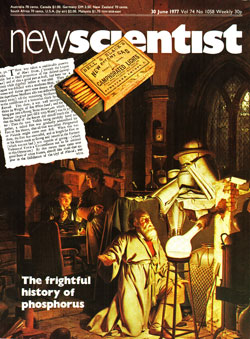 Frightful Phosphorus
Frightful Phosphorus- This article was a spin-off from the textbook The Chemistry of Phosphorus which I'd written with a colleague, Dennis Hall, and which was published in 1976. The article contains human interest stories that were not really suitable for a textbook. When something as dangerous as phosphorus is discovered long before its chemistry was understood, then it was liable to be misused, and indeed it was – in medicine, murder, munitions and matches.
The shocking history of phosphorus
John Emsley
Published: 30 June 1977
Jealousy and intrigue surrounded the discovery of phosphorus. Even the actual date of the element's discovery is not certain because the discoverer, the German alchemist Hennig Brandt of Hamburg, kept it secret for several years. News of the wonderful new material that glowed eerily in the dark eventually leaked out about 1675 and Brandt was pressed by Johann Kunckel, the pharmacist to the Prussian Court, to divulge the secret of its manufacture. At first he resisted but later sold the information to Kunckel's friend Daniel Kraft for 200 thalers (about £5O then and £1000 now). Kraft toured the capitals of Europe exhibiting the new discovery.
He brought a sample of phosphorus to London and exhibited its remarkable luminosity to King Charles II in 1677. The great English chemist Robert Boyle was shown the new wonder and naturally tried to obtain the secret of its preparation. Kraft, however, was unwilling to divulge it although, in exchange for other information from Boyle, he revealed that it originated from "somewhat that belonged to the body of man".
As we now know, phosphorus is one of the elements essential to life, so Boyle could have used any part of living matter as his starting point for a preparation. Brandt had employed evaporated urine which contains sodium ammonium hydrogen phosphate (NaNH4HPO4), and urea – (NH2)2CO. When strongly heated, this mixture gives off phosphorus vapour which can be condensed under water as a soft white solid. This was the new phosphorus. "New" because phosphorus was the name given by alchemists to several materials that would glow in the dark without being heated. The term comes from the Greek words phos and phorus meaning light bearing. The early chemists knew of several phosphoruses–glow worms, rotten fish, Bologna stone (barium sulphate mineral), and Bauduin's stone (phosphorescent calcium nitrate, discovered about 1668). The name phosphorus eventually stuck to the new element, which outshone the rest, and phosphorus it has remained to this day.
Try as they may, Boyle and his assistant, Ambrose Godfrey, could not produce the new phosphorus from urine, which they had rightly decided was the "somewhat" that Kraft had referred to. It was only as a result of further inquiries made by Godfrey while on a visit to Germany that they learned of the very high temperatures (red heat) necessary for the reaction. With this information they succeeded in making the new material, which Boyle called noctiluca (nightlight).
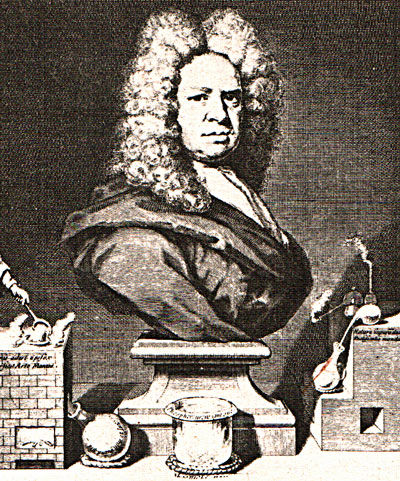 Ambrose Godfrey-Hancwitz
Ambrose Godfrey-Hancwitz- Boyle's assistant who later sold phosphorus in Covent Garden.
Boyle, too, wished to keep the method of phosphorus manufacture secret and so he deposited the recipe with the Royal Society on 14 October, 1680 in a sealed envelope not to be opened until his death. It was published in January 1692, a month after Boyle died. Meanwhile Godfrey continued to manufacture high grade white phosphorus from animal urine and dung. He sold the product from his shop in Covent Garden and his firm had a virtual monopoly of the market for 100 years. It was sold wholesale for £2.50 per ounce (1685 prices).
Even before Kraft sailed for London in 1677, Kunckel had tried unsuccessfully to persuade Brandt (and then Kraft) to reveal the secret of phosphorus. Kraft dropped the same hint to Kunckel that he later let slip to Boyle. Kunckel set to work on his own and within six months had discovered the manufacturing method for himself. He too went into business, selling "luminous pills", each of which held 3 grains (200 milligrams) of phosphorus. They were claimed to have a calming effect and were recommended as a suitable treatment for colic (undiagnosed lead poisoning), asthma, tetanus, apoplexy, and gout. In many cases they relieved the symptoms by the simple if severe expedient of removing the patient. Had the phosphorus been pure, each pill would have contained twice the lethal dose! One can only assume that a pandemic of phosphorus poisoning was averted only because most of the active ingredient must have been oxidised into harmless phosphate by the time the pill was swallowed.
The popularity of phosphorus as a medicament received a boost in 1779 when the German chemist Hensing extracted it from brain tissue. This discovery led to the popular theory that phosphorus was linked to intelligence; a mean intelligence was supposed to indicate too little phosphorus, but too much overstimulated the brain into madness. The French chemist Couerbe wrote in 1830:
"The want of phosphorus in the brain would reduce man to the sad condition of the brute; an excess of this element irritates the nervous system, excites the individual and throws him into that terrible state of disturbance called madness - or mental alienation; a moderate proportion gives rise to the sublimest ideas and produces that admirable harmony which spiritualists call the soul".
But in living things it is not the elemental form of phosphorus that is an essential component, rather the phosphate ion PO43-. Indeed, added phosphate eventually became a food fad and medicinal compound in the nineteenth century. However, white phosphorus, dangerous though it was, continued to be a part of the repertory of medicines for almost 300 years. The amount prescribed was reduced to a maximum of an eighth of a grain (8 mg) in the nineteenth century, and a twentieth of a grain (3 mg) in this century. Pills containing phosphorus did not disappear from the pharmacopoeias until after the Second World War. Treatment involving elemental phosphorus is beneficial for no condition and it is surprising that it persisted for so long.
The small amounts of phosphorus required by the early chemists and physicians could be produced from animal excreta, and was so produced for almost 100 years. Then, in 1769, the wealthy Swedish mineralogist and chemist Johan Gahn discovered that bones were chiefly calcium phosphate. In the following year his friend and co-worker the great Swedish chemist Carl Wilhelm Scheele (the son of a poor apothecary) published this information and followed it with the details of his own process whereby phosphorus could be produced from bone ash. His method, slightly modified, became the basis of the emergent phosphorus industry. It consisted of treating bone ash with sulphuric acid to convert it to phosphoric acid and insoluble calcium sulphate, which was filtered off. The phosphoric acid was evaporated to a syrup and then heated with charcoal and sand in earthenware retorts. Phosphorus vapour was given off and condensed under water. The method was later adapted to mineral phosphates as a raw material in the following century, but was essentially unchanged for about 100 years. The largest phosphorus manufacturer in the Empire was Messrs Albright and Wilson of Oldbury, Birmingham, and the mineral ore it used was sombrerite, an aluminium calcium phosphate, from the West Indies.
In the 1890s the manufacture of phosphorus was greatly improved by the introduction of the electric furnace. This cut out the sulphuric acid step, calcium phosphate rock itself being reacted directly with coke and sand at temperatures above 1500°C. This method is the one which is still commonly used. The chemistry of all these processes is the reduction of phosphate to phosphorus by carbon, the sand serving to remove metal components as silicate slag.
From a chemical curiosity in the eighteenth century, phosphorus emerged as a household material in the nineteenth century. Even so the amounts manufactured were relatively small by present day standards: 200 tons in 1875, 1000 tons in 1900, compared to over 2 million tons worldwide today (primarily for making pure phosphoric acid and phosphates for fertilisers and detergents).
Strike a light
The invention that consumed most of the white phosphorus made in the last century was the household match. 1780 saw the first prototype matches, which consisted of a wax taper with a phosphorus tip, enclosed in a sealed glass tube. Breaking the tube and withdrawing the match exposed the phosphorus to air causing it to ignite. These devices were little more than amusing toys. Matches as we know them are friction matches and were first made by John Walker, a chemist from Stockton in 1826. He called them lucifers and used antimony sulphide, not phosphorus, to start the flame. This made them rather difficult to light.
Matches became really popular only after 1831 when phosphorus was introduced (by Charles Sauria) as the igniter. These matches were called congreves (after Sir William Congreve who died in 1828) or lucifers and had heads consisting of phosphorus, oxidising agents such as potassium chlorate, fine abrasive powder such as sand, and blue dye, held together by glue which served to protect the phosphorus from the air. Each of these "strike anywhere" matches contained about 2 mg of white phosphorus. They were cheap, and in an age of gas lighting and coal fires, quickly became a necessity.
There were, however, two unpleasant side effects of lucifers – they were very poisonous and could easily be ignited accidentally. The former danger was removed by replacing the white phosphorus by red phosphorus (a much less hazardous polymeric form of the element) or by tetraphosphorus trisulphide which was introduced in the 1890s. The second hazard was overcome by the Swede J.E. Lundstrom who invented the safety match. In this the phosphorus was separated from the oxidising agent. Red phosphorus and the abrasive were excluded from the match head and stuck to the side of the box so that the match would only ignite when rubbed along a strip on the box. Although safety matches were invented in 1855 they were more expensive and so did not displace lucifers for many decades.
There were many accidental and deliberate poisonings blamed on phosphorus matches, but the people most affected were the men who made the phosphorus and the women who made the matches. They often fell victim to a disease called "phossy-jaw", one of the most harrowing of industrial poisonings. It was caused by breathing air containing phosphorus vapour. About one worker in 20 in the match industry suffered from phossy-jaw. The effects of chronic phosphorus poisoning were particularly disfiguring. The condition started with a sore mouth and toothache. It progressed by attacking the teeth and gums and worked its way inwards causing decay until eventually it corroded away the victim's jaw bone. Open sores allowed easy access to infection and death from septicemia was the common fate.
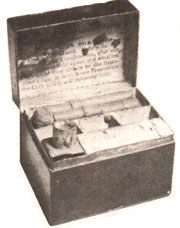 Phosphorus Box
Phosphorus Box- A phosphorus box made by S. Jarvis of London between 1795 and 1805. A taper is inserted into the bottle (which is coated inside with phosphorus) and then rubbed against a piece of cork to ignite the phosphorus.
The light to abolish lucifers was led by the Salvation Army whose investigators uncovered the appalling conditions in the industry. English employers had resisted the threat to their industry from safety matches by flooding the market with lucifers selling as cheaply as one penny per dozen boxes. This low price was made possible by long hours and low wages. One woman and her two children, aged under nine worked 16 hours for a combined wage of 1s 3 ¾ d per day (about £1.30 at today's prices). They ate their meals as they worked.
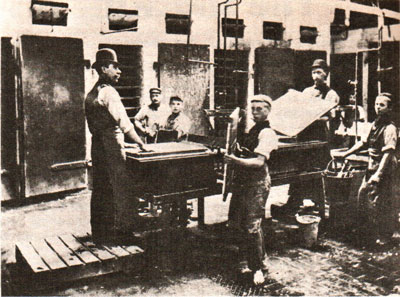 Phosphorus workers
Phosphorus workers- Match workers dipping frames of matches in phosphorus (middle). The results of their work are shown in this picture (far right) of the lower jaw of a 35-year-old worker.
General Booth acted to end this state of affairs in a practical way-he opened a model match factory in 1891 making safety matches which sold at twice the price of lucifers. At the same time he led a vigorous propaganda campaign against lucifers until the industry was forced to put its house in order. Although, as we have seen, white phosphorus was eventually removed from matches, it continued to find a role as an incendiary agent in fireworks and firebombs. Phosphorus firebombs were the most immoral use to which the element has ever been put. These devices played a minor but terrible part in the frenzied urban holocausts inflicted on European and Japanese cities in the latter half of the Second World War. The burns produced by droplets of blazing phosphorus were notorious for their deep penetration, intense pain, and slowness in healing. Deployment of these weapons led to the same feeling of outrage that a later generation expressed about napalm.
The phosphorus poisoners
White phosphorus is very poisonous and lucifers were often blamed for accidental and deliberate deaths. There were about 12 deaths per year from phosphorus poisoning throughout the nineteenth century. Roughly half were suicides, a quarter murders, and the rest accidental. (Deaths or disability from phossy jaw are not included in these figures.) Soaking match heads in brandy or wine was one way of producing a lethal drink which found favour with women seeking abortions and men seeking aphrodisiacs. Both groups erred in their beliefs and mortalities were over 90 per cent among those who tried it. The myth that phosphorus was linked to intelligence led some to experiment by consuming match heads as a method of improving their minds. Their efforts taught them naught save that phosphorus is a deadly poison. Lucifers were eventually banned in 1906 by international agreement.
The toxicity of white phosphorus was deliberately exploited in rodenticides. Bran-based paste containing 4 per cent white phosphorus was introduced in the 1830s and was widely used in Europe throughout the last century. One brand, called Rodine, was on sale in Britain until 1963 when it was finally outlawed by the Animal (Cruel Poisons) Act.
White phosphorus kills by destroying the liver, the vital organ which tries desperately to remove the poison from the body. It is only slowly absorbed into the system; nevertheless death may occur within a day if a large enough dose (over 100 mg) is ingested. Smaller doses may produce the same initial reaction of vomiting as large doses but then some signs of recovery may follow. However, this recovery is only temporary since the failure of the liver has already begun. The liver swells as the failure proceeds and within two days it may cease to function effectively. The victim suffers symptoms typical of liver disease such as hepatitis, that is vomiting, diarrhoea, and jaundice. Death from phosphorus poisoning occurs in these cases after about five days.
Doctors were readily alerted to cases of phosphorus poisoning by the garlic smell of the victim's breath and his or her raging thirst. But there was little that could be done to save them and even today there is no specific antidote for this poison. Would-be-murderers who chose phosphorus were often thwarted by the distinctive and difficult to disguise taste or smell of the poison. One intended victim was even saved by its phosphorescence, when he noticed that the soup he was carrying from the kitchen shone in the dark!
It may have been difficult to persuade a victim to take white phosphorus but it could be done. Once this step had been achieved, murderers could take some comfort in the fact that it was difficult for forensic scientists to show that any phosphorus had entered the body. Its rapid oxidation and hydrolysis to phosphite and phosphate made it almost impossible to detect, even in the bodies of suicides who had taken known doses of rat poison. Analysis for white phosphorus by the Mitscherlich test relied on its phosphorescence. A suspect sample is acidified and heated to cause distillation. In a dark room any phosphorus present can then be seen distilling and the amount measured by oxidising the distillate to phosphate and analysing that by a variety of methods.
The north of England saw an outbreak of Rodine murders in the 1950s two of which became famous for their forensic aspects. In April 1955 Louisa Merrifield became housekeeper to an old lady, Mrs Ricketts, who foolishly revealed that she had left Louisa all her property in her will. Louisa repaid this generosity by giving Mrs Ricketts rum and Rodine cocktails. But no phosphorus was found in the organs of the unhappy Mrs Rickett's body. A little (9 mg) was recovered from the stomach and intestines along with the tell-tale bran of the rat poison. In March 1958 at the Leeds Assizes, 66-year-old Mary Wilson was found guilty of disposing of two aged husbands. A notable feature of this case was the ability of the forensic chemists to detect phosphorus, by the Mitscherlich test, in both bodies, including that of her first husband who had been buried for over a year. The anaerobic conditions of their burials had preserved just enough of the poison against oxidation to make its detection possible. This was a remarkable analytical achievement but a skill that, luckily, was not to be required for much longer. With the disappearance of phosphorus rat poison (which had been responsible for half the nineteenth century deaths due to phosphorus), the murders came to an end.
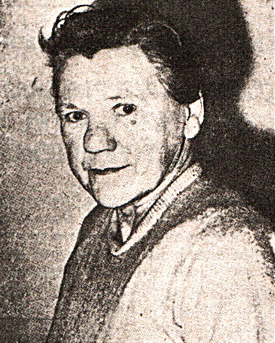 Phosphorus poisoner
Phosphorus poisoner- Mary Wilson was just one in a series of poisoners who took advantage of phosphorus is toxicity to dispose of their victims.
Elemental phosphorus played an important part in the development of chemistry since it was a useful starting material for hundreds of new compounds, but to allow it to escape from the laboratory and into the world at large was an act of folly. Today it is safely tamed and back in its cage; but when that cage is a rail tanker holding molten phosphorus (which is how it is transported in the United States for example), one wonders how long it will be before it strikes again.